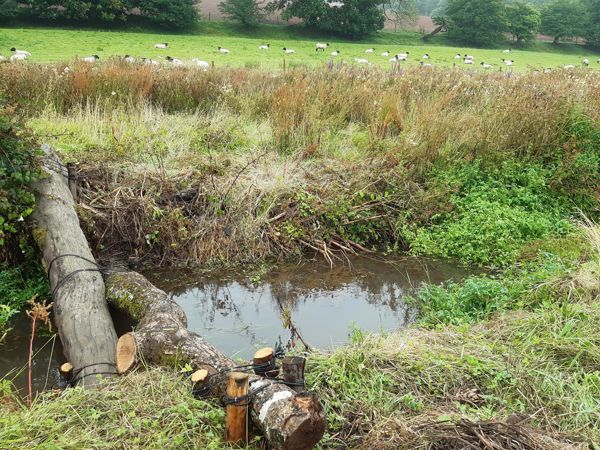Best practice showcased at Pembroke river restoration project

A recently restored section of the Pembroke river, near Milford Haven, will be used as a demonstration site for future river restoration projects following a series of interventions to improve the health of the river and the estuary downstream.
Delivered by Natural Resources Wales in collaboration with the landowner, large woody material has been placed into a 200 metre stretch of the river in a bid to restore natural river processes and ‘re-wiggle’ the river.
This helps to create different flows within the river, and encourage natural bends, known as meanders, to form over time. These are currently lacking in the river as it has historically been straightened for human purposes.
The wood also traps silt and debris, encouraging the regeneration of habitat for invertebrates and other species. It provides shelter for migratory fish who travel upstream to reach spawning grounds.
To reduce soil erosion and improve water quality, 570 metres of fencing has been installed to prevent livestock from entering the river with new, alternative drinking water sources introduced.
With support and funding from the Pembroke River Restoration Project Partnership, 600 trees were also planted to create a woody corridor alongside the river. Once matured, the trees will provide a buffer zone between productive agricultural land and the river, reducing nutrient run-off impacting on water quality.
NRW now hopes to use the project to showcase river restoration practices using nature-based solutions.
Andrew Lewis, from NRW’s Marine Projects Team said:
“Sadly, many of our rivers no longer function in their natural state due to human interference, climate change and pollution. This can have huge impacts on water quality, habitat and wildlife in some of our most protected rivers and estuaries.
“As well as impacting the environment, the recurring issues in the Pembroke River and the Pembroke Mill Ponds are having a negative impact on community wellbeing and local tourism.
“The nature-based solutions delivered here are simple but effective, and will contribute to wider efforts and initiatives to drive down nutrient pollution in our waterways.
“The project highlights the importance of partnership-driven conservation efforts, and it is our ambition to showcase what we’ve achieved here so it can successfully be replicated elsewhere.”
The Milford Haven Waterway is designated as a Marine Special Area of Conservation, while significant stretches of its coastline are also designated as a Site of Special Scientific Interest.
Both the Pembroke river, and the Milford Haven inner transitional water, are both failing to meet ‘good’ water quality status. High levels of soil erosion and nutrients cause sedimentation and algal blooms in the nearby Pembroke Mill ponds each summer. Mud also gets deposited on protected habitats such as maerl beds in the Haven, which is a protected feature of the SAC.
The project has been funded by the Welsh Government’s Water Capital Programme, which supports a number of environmental priorities including river restoration, metal mine remediation, fisheries and water quality.
